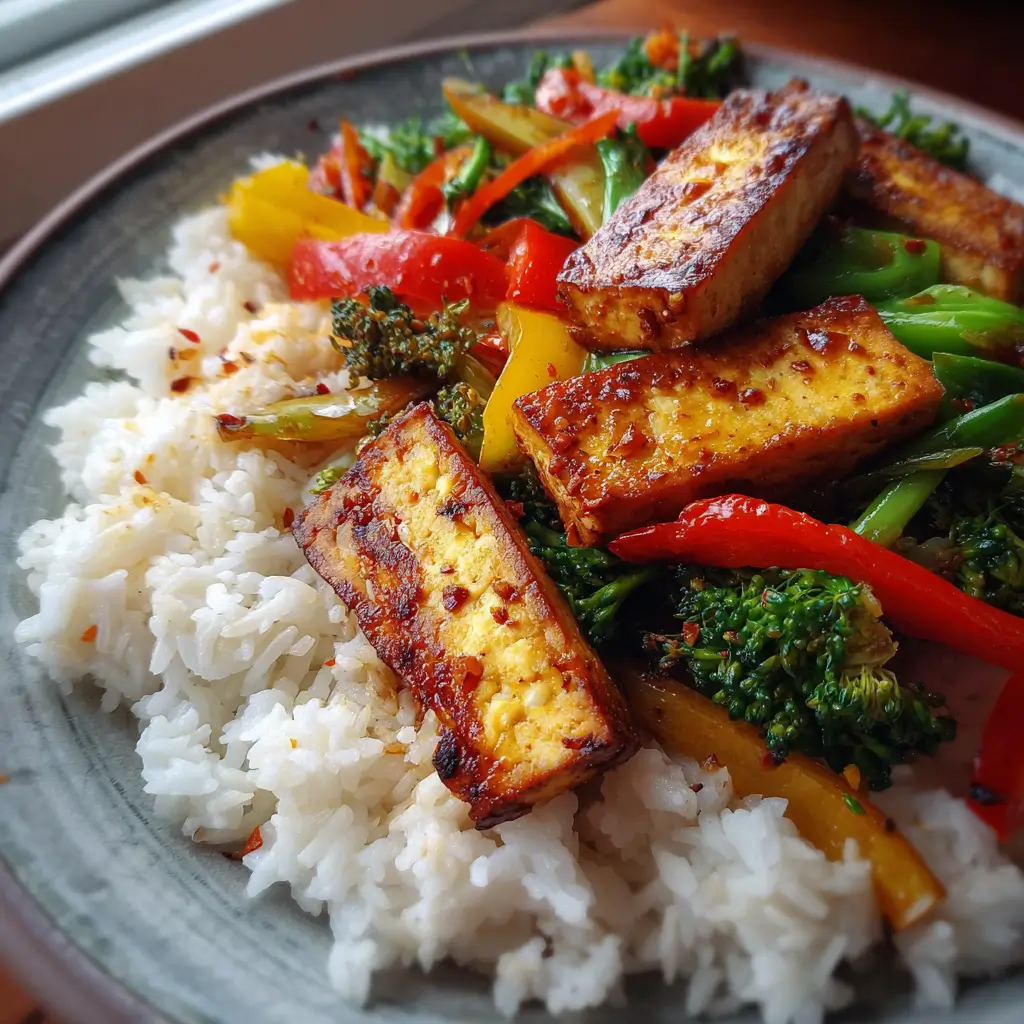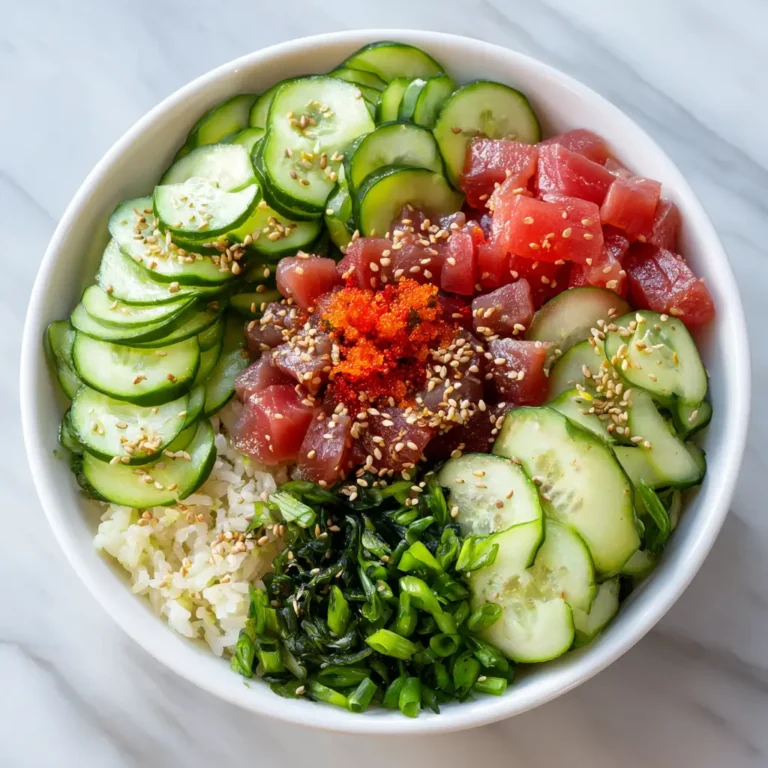Seared Tofu Stir‑Fry
Seared Tofu Stir-Fry: A Flavor-Packed Plant-Based Delight
The History
Stir-frying is a culinary technique deeply rooted in Chinese cooking, dating back over 2,000 years to the Han Dynasty. The method was developed as an efficient way to cook food quickly using minimal fuel, making it ideal for bustling households and street vendors alike. Tofu, on the other hand, has been a staple in East Asian diets since at least the Western Han period (around 2nd century BCE), believed to have been invented by accident when a Chinese cook curdled soy milk. Over centuries, tofu spread across Asia, adapting into various regional cuisines—from Japanese agedashi tofu to Korean dubu jorim. The combination of seared tofu with stir-fried vegetables represents a modern fusion of traditional techniques and global palates. As plant-based eating surged in popularity in the 21st century, seared tofu stir-fry emerged as a beloved dish among vegans, vegetarians, and flexitarians worldwide. Its versatility allows home cooks to blend flavors from multiple cultures—be it Thai-inspired coconut aminos, Korean gochujang, or Mediterranean herbs—making it not just a meal but a canvas for culinary creativity.
Ingredients Breakdown
The magic of seared tofu stir-fry lies in its balance of textures and flavors, each ingredient playing a pivotal role:
- Firm or Extra-Firm Tofu: Essential for holding shape during high-heat searing. Its porous nature absorbs marinades and sauces beautifully.
- Vegetables: Common choices include bell peppers (for sweetness and color), broccoli (crisp-tender texture), carrots (earthy crunch), snap peas (fresh pop), mushrooms (umami depth), and onions (aromatic base).
- Aromatics: Fresh garlic, ginger, and green onions form the flavor foundation, releasing fragrant oils when sautéed.
- Sauce Base: Soy sauce or tamari (gluten-free option) provides saltiness; rice vinegar or lime juice adds brightness; maple syrup or agave lends subtle sweetness; sesame oil deepens aroma.
- Thickener: Cornstarch or arrowroot powder helps create a glossy, clingy sauce that coats every bite.
- Oil: High smoke-point oils like avocado, grapeseed, or refined coconut oil are ideal for searing without burning.
- Garnishes: Toasted sesame seeds, chopped cilantro, sliced red chili, or crushed peanuts add finishing flair.
Optional enhancements include sriracha for heat, miso paste for fermented complexity, or nutritional yeast for a cheesy undertone.
Step-by-Step Recipe
- Press the Tofu: Remove tofu from packaging and drain liquid. Wrap in clean kitchen towels or paper towels. Place on a plate with a heavy object (like a cast-iron skillet) on top. Press for 20–30 minutes to remove excess moisture. This ensures better browning.
- Cut and Marinate: Slice tofu into ¾-inch cubes or triangles. In a bowl, toss with 1 tbsp soy sauce and 1 tsp cornstarch (optional for crispier crust). Let sit 10–15 minutes.
- Prepare Sauce: Whisk together 3 tbsp soy sauce, 1 tbsp rice vinegar, 1 tbsp maple syrup, 1 tsp sesame oil, 1 minced garlic clove, 1 tsp grated ginger, and 1 tsp cornstarch in a small bowl. Set aside.
- Chop Vegetables: Cut all vegetables into uniform sizes for even cooking. Keep aromatics separate.
- Sear the Tofu: Heat 1–2 tbsp oil in a wok or large skillet over medium-high heat. Add tofu in a single layer. Cook undisturbed for 3–4 minutes until golden brown on one side. Flip and sear other sides until crispy. Remove and set aside.
- Stir-Fry Veggies: In the same pan, add a bit more oil if needed. Sauté onions and carrots for 2 minutes. Add harder vegetables like broccoli and bell peppers; stir-fry 3–4 minutes. Then add softer ones like mushrooms and snap peas; cook 2 more minutes. Finally, add garlic and ginger; stir 30 seconds until fragrant.
- Combine: Return tofu to the pan. Pour sauce over and stir gently to coat. Cook 1–2 minutes until sauce thickens and bubbles.
- Finish: Stir in green onions. Taste and adjust seasoning—add more soy sauce for salt, vinegar for tang, or sweetener for balance.
- Serve: Plate immediately over steamed rice, quinoa, noodles, or cauliflower rice.
Tips
- Dry Tofu = Crispier Results: The drier your tofu, the better it will sear. Consider freezing tofu first, then thawing and pressing—it creates a chewier, more sponge-like texture that absorbs sauce better.
- Use a Wok or Carbon Steel Pan: These retain and distribute heat evenly, crucial for authentic stir-fry texture.
- Prep Ahead: Chop everything before heating the pan. Stir-frying is fast-paced; having ingredients ready prevents overcooking.
- Don’t Crowd the Pan: Cook tofu in batches if necessary. Overcrowding causes steaming instead of searing.
- High Heat is Key: Maintain medium-high to high heat throughout to achieve wok hei (the “breath of the wok”)—a smoky flavor characteristic of great stir-fries.
- Layer Flavors: Add aromatics late to prevent burning. Use toasted sesame oil only at the end or in sauces, as its low smoke point can make it bitter when heated directly.
- Sauce Control: If sauce gets too thick, add a splash of vegetable broth or water. If too thin, mix ½ tsp cornstarch with 1 tbsp water and stir in.
Variations and Customizations
One of the greatest strengths of seared tofu stir-fry is its adaptability. Here are some creative twists:
- Thai Basil Tofu: Add Thai basil, red chili, and a splash of fish sauce (or vegan fish sauce) for a spicy, aromatic profile.
- Korean-Inspired: Use gochujang (Korean chili paste) in the sauce, garnish with kimchi, and serve with brown rice.
- Peanut Satay Style: Mix in 1–2 tbsp creamy peanut butter into the sauce for a rich, nutty twist.
- Mediterranean Twist: Swap soy sauce for balsamic glaze, add olives and sun-dried tomatoes, and finish with fresh oregano.
- Curry Coconut: Replace soy sauce with light coconut milk and yellow curry paste for a creamy, fragrant version.
- Low-Carb Option: Skip grains and serve over zucchini noodles or shredded cabbage.
- Protein Boost: Add edamame, tempeh, or chickpeas alongside tofu.
- Seasonal Swaps: In spring, use asparagus and baby bok choy; in fall, try Brussels sprouts and sweet potatoes.
You can also turn this stir-fry into a noodle bowl by tossing with soba, udon, or rice noodles. For meal prep, store components separately to maintain texture.
Health Considerations and Nutritional Value
Seared tofu stir-fry is not only delicious but also nutritionally balanced when prepared thoughtfully. Tofu is a complete protein, containing all nine essential amino acids. It’s rich in iron, calcium (especially if made with calcium sulfate), and isoflavones, which may support heart health and hormonal balance. However, individuals with soy allergies or thyroid concerns should consult a healthcare provider, as soy can interfere with thyroid medication absorption in sensitive cases.
Vegetables provide fiber, vitamins (A, C, K), and antioxidants. Broccoli contains sulforaphane, known for anti-cancer properties; bell peppers are high in vitamin C; carrots offer beta-carotene. Using minimal oil and low-sodium soy sauce makes the dish heart-healthy and suitable for blood pressure management.
Nutritionally, a typical serving (without rice) contains approximately:
- Calories: 280–350
- Protein: 18–22g
- Fat: 14–18g (mostly unsaturated)
- Carbohydrates: 20–25g
- Fiber: 6–8g
- Sodium: 700–900mg (can be reduced with low-sodium soy sauce)
To enhance nutrient absorption, pair with vitamin C-rich ingredients (like bell peppers or citrus) to boost iron uptake from tofu. For a lower-fat version, reduce oil by using a non-stick pan or broth for sautéing.
Ingredients
- 1 block (14–16 oz) extra-firm tofu, pressed and cubed
- 2 tbsp neutral oil (avocado, grapeseed, or refined coconut), divided
- 1 red bell pepper, sliced
- 1 cup broccoli florets
- 1 carrot, julienned or thinly sliced
- 1 cup snap peas
- 4 oz mushrooms (shiitake or cremini), sliced
- 1 small onion, sliced
- 3 garlic cloves, minced
- 1 tbsp fresh ginger, grated
- 2 green onions, sliced (white and green parts separated)
- Salt and black pepper to taste
For the Sauce:
- 3 tbsp soy sauce (or tamari for gluten-free)
- 1 tbsp rice vinegar or lime juice
- 1 tbsp pure maple syrup or agave nectar
- 1 tsp toasted sesame oil
- 1 tsp cornstarch
- 2–3 tbsp water or vegetable broth
For Garnish:
- 1 tbsp toasted sesame seeds
- Chopped cilantro or Thai basil
- Red pepper flakes or sliced chili (optional)
Directions
- Press tofu for 20–30 minutes. Cut into ¾-inch cubes. Toss with 1 tbsp soy sauce and 1 tsp cornstarch. Set aside.
- In a small bowl, whisk together all sauce ingredients until smooth. Set aside.
- Heat 1 tbsp oil in a large wok or skillet over medium-high heat. Add tofu in a single layer and sear 3–4 minutes per side until golden and crisp. Remove and set aside.
- Add remaining 1 tbsp oil to the pan. Sauté onion and carrot for 2 minutes.
- Add broccoli and bell pepper; stir-fry 3–4 minutes until bright and slightly tender.
- Add mushrooms and snap peas; cook 2 minutes more.
- Push veggies to one side. Add garlic, ginger, and white parts of green onions to center; stir 30 seconds until fragrant.
- Return tofu to pan. Stir everything together.
- Pour sauce over the mixture. Stir constantly for 1–2 minutes until sauce thickens and coats ingredients evenly.
- Remove from heat. Stir in green onion tops and sesame oil.
- Taste and adjust seasoning. Add salt, pepper, or extra sweet/sour elements as desired.
- Serve hot over rice, noodles, or grain bowls. Garnish with sesame seeds and herbs.
FAQ
Can I use soft tofu?
No, soft or silken tofu lacks structure and will fall apart when stir-fried. Stick to firm or extra-firm for best results.
How do I store leftovers?
Keep in an airtight container in the refrigerator for up to 4 days. Reheat in a skillet to preserve texture; microwaving may make tofu rubbery.
Can I freeze this dish?
Yes, though the texture of tofu becomes chewier after freezing and thawing. Sauce may separate slightly—stir well when reheating.
Is this recipe gluten-free?
Yes, if you use tamari instead of soy sauce and ensure all other ingredients (like sauces or garnishes) are certified gluten-free.
Why didn’t my tofu get crispy?
Moisture is the enemy of crispiness. Make sure to press thoroughly, use high heat, and avoid overcrowding the pan.
Can I bake the tofu instead of searing?
Absolutely! Toss pressed tofu with oil and cornstarch, then bake at 400°F (200°C) for 25–30 minutes, flipping halfway, until golden and crisp.
What can I substitute for cornstarch?
Arrowroot powder works similarly. For a grain-free option, use tapioca starch. Note: flour may leave a cloudy appearance.
Summary
Seared tofu stir-fry is a vibrant, nutrient-dense dish that combines crispy tofu with colorful vegetables in a savory-sweet sauce, offering endless customization possibilities. Quick to prepare and deeply satisfying, it’s a perfect weeknight meal that celebrates plant-based eating at its finest.






